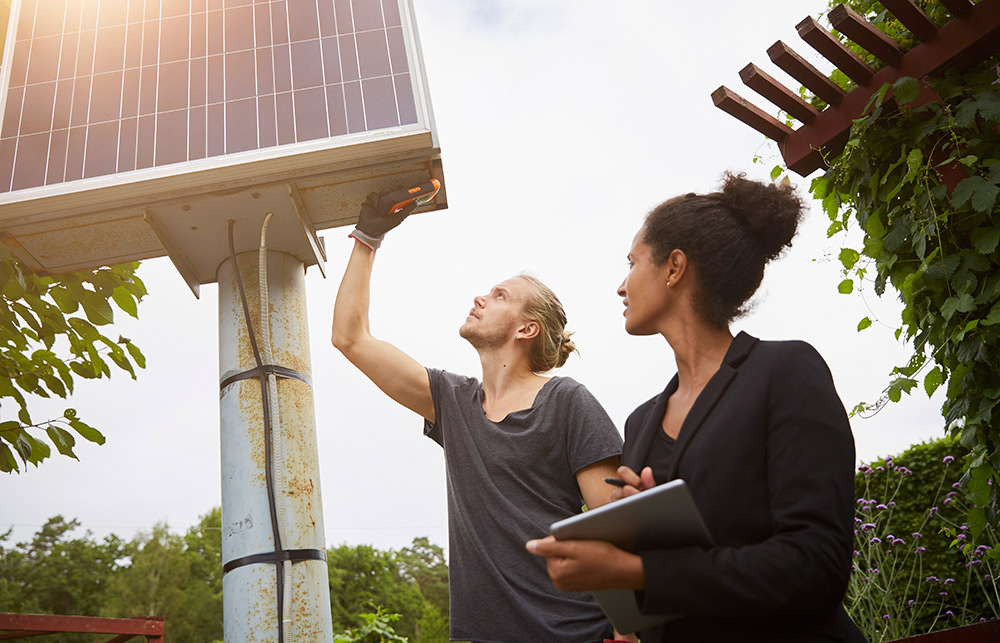
受新冠肺炎疫情影響,美國(guó)的失業(yè)率已經(jīng)上升至“大蕭條”時(shí)代以來的最高水平,。在“后疫情時(shí)代”,,很多工作崗位將永遠(yuǎn)消失,,還有一些就業(yè)崗位可能需要幾年的時(shí)間才能恢復(fù)到正常水平。不過有危必有機(jī)?,F(xiàn)在,,我們有一個(gè)千載難逢的機(jī)會(huì)來解決當(dāng)前的經(jīng)濟(jì)危機(jī)——推動(dòng)能源向清潔能源轉(zhuǎn)型。
根據(jù)非盈利機(jī)構(gòu)Rewiring America最近的一項(xiàng)研究估計(jì),,如果美國(guó)的能源體系由化石能源轉(zhuǎn)向電能,,那么到2035年,美國(guó)經(jīng)濟(jì)將新增2500萬個(gè)就業(yè)崗位,。這個(gè)結(jié)果是兩名筆者與麻省理工學(xué)院的工程師山姆·卡利奇對(duì)能源,、勞動(dòng)力和材料等領(lǐng)域的復(fù)雜數(shù)據(jù)進(jìn)行了深入的能源分析和工程分析后得出的。我們非常清楚地知道,,我們目前的能源來自哪里,,我們的能源使用量是多少,我們需要怎樣建設(shè),,才能將現(xiàn)有能源體系轉(zhuǎn)型成一個(gè)零排放的能源體系,,以及我們到底需要多少人來生產(chǎn)轉(zhuǎn)型所需的相關(guān)產(chǎn)品和設(shè)備。
簡(jiǎn)而言之,,清潔能源技術(shù)在制造,、安裝和維護(hù)方面,比化石能源技術(shù)需要更多的勞動(dòng)力,。舉個(gè)簡(jiǎn)單的例子,,在能源產(chǎn)出相等的前提下,要安裝和維護(hù)一座風(fēng)力發(fā)電廠,,需要的人肯定比打一口油井以及維護(hù)這口油井的人多,。所有這些工作都具有倍增效應(yīng)——安裝風(fēng)力發(fā)電設(shè)施的婦女將獲得一份豐厚的收入,這些收入又能帶入當(dāng)?shù)亟?jīng)濟(jì),,促進(jìn)當(dāng)?shù)夭惋?、商店和其他被疫情重?chuàng)的企業(yè)的復(fù)蘇。
在不依賴化石能源的前提下,,要想繼續(xù)保持目前的生活舒適水準(zhǔn)(比如汽車,、房屋供暖以及其他家電設(shè)備),美國(guó)的發(fā)電能力必須達(dá)到1500千兆瓦,,也就是美國(guó)目前發(fā)電量的三倍多,。這么大規(guī)模的能源電力化工程,是美國(guó)近幾十年來的所有建設(shè)項(xiàng)目均無法比擬的,。我們至少需要幾十萬個(gè)風(fēng)力渦輪機(jī),、600萬輛零排放卡車、100萬英里的傳送線纜,、幾億輛電動(dòng)汽車,、不計(jì)其數(shù)的熱泵和電動(dòng)感應(yīng)裝置,,以及幾十上百億塊太陽能發(fā)電板和超過一萬億塊電池。而且,,我們還需要幾千萬個(gè)工作崗位來生產(chǎn),、建設(shè)、安裝和管理所有這些東西,。
到時(shí)候,,全國(guó)各地都會(huì)有與清潔能源相關(guān)的工作崗位,因?yàn)槲覀冃枰腥嗽诜宽斏习惭b太陽能電板,,有人在田野里安裝風(fēng)力發(fā)電機(jī),。這些工作是無法外包給其他國(guó)家的,只能由本地人來做,。因此,,受疫情重創(chuàng)的人們將有機(jī)會(huì)找到新的好工作,同時(shí)也能幫助所在社區(qū)獲得更清潔和更安全的能源,。
我們已經(jīng)有了能讓美國(guó)實(shí)現(xiàn)電力化的技術(shù)方案,,但我們也需要新的政策和資金。能源體系的清潔化轉(zhuǎn)型需要更高的前期成本,,需要建設(shè)新的分布更廣的電力基礎(chǔ)設(shè)施,。這些基礎(chǔ)設(shè)施很多都是屬于私人的——比如你屋頂上的太陽能電板和你車庫里的電動(dòng)汽車,所以我們也需要一些低成本的融資來促進(jìn)能源轉(zhuǎn)型,。
在“大蕭條”之后,,美國(guó)推出了羅斯福新政,其中包括一系列就業(yè)計(jì)劃和金融創(chuàng)新,,它們?yōu)橐恍┟绹?guó)人提供了購買房屋和電器的機(jī)會(huì),,也讓一些人的生活穩(wěn)定了下來。不過當(dāng)時(shí),,美國(guó)的黑人仍然沒有權(quán)利申請(qǐng)聯(lián)邦抵押貸款,。今天,我們可以向老百姓提供更廣泛,、更公平的“氣候貸款”,,讓所有人的能源從“燒油”變成“燒電”。
那么,,這一切的代價(jià)是什么呢,?有了適當(dāng)?shù)娜谫Y,,這個(gè)就業(yè)解決方案不會(huì)花費(fèi)普通美國(guó)老百姓的任何前期投資,。此外,只要新的基礎(chǔ)設(shè)施建立起來了,,可再生的電能將會(huì)非常便宜——畢竟陽光和風(fēng)都是大自然免費(fèi)的饋贈(zèng),。估計(jì)美國(guó)每個(gè)家庭每年平均可以省下2000美元的電費(fèi),。這對(duì)低收入人群是一個(gè)巨大的實(shí)惠,而他們也是受能源價(jià)格波動(dòng)影響最大的群體,。而當(dāng)能源便宜了,,一切也就便宜了。
除了明智的融資政策,,我們還需要在監(jiān)管方面進(jìn)行改革,,修訂建筑領(lǐng)域的法律法規(guī),便利能源的電力化和太陽能發(fā)電設(shè)施的安裝,。為了使這個(gè)系統(tǒng)順利運(yùn)行,,我們還需要做到“電網(wǎng)中立”,使每個(gè)人都可以自由和民主地交換能源,,就像我們?cè)诨ヂ?lián)網(wǎng)上交換信息一樣,。
要實(shí)現(xiàn)這個(gè)目標(biāo),就需要政府進(jìn)行一次具有歷史意義的動(dòng)員和投資,,但美國(guó)以前就曾這樣做過,。比如在二戰(zhàn)期間,為了對(duì)抗希特勒,,拯救西方民主制度,,美國(guó)必須迅速擴(kuò)充軍備,當(dāng)時(shí),,美國(guó)向轉(zhuǎn)型生產(chǎn)軍火的企業(yè)提供了大量資本,,并擔(dān)保這些企業(yè)能獲得7%的利潤(rùn),這也就是所謂“愛國(guó)的7%”,。這個(gè)策略取得了成功,。在“大蕭條”最嚴(yán)峻的時(shí)候,美國(guó)的失業(yè)率超過了24%,。而到了1944年,,憑借美國(guó)的戰(zhàn)時(shí)生產(chǎn)體制,美國(guó)的失業(yè)率降到了1.2%,。我們估計(jì),,美國(guó)向零排放經(jīng)濟(jì)轉(zhuǎn)型的成本,至少比二戰(zhàn)期間“全民造軍火”的成本要低,。
現(xiàn)在,,就像二戰(zhàn)和“大蕭條”時(shí)期一樣,我們也有了一個(gè)走出危機(jī)的難得的機(jī)會(huì),。而且我們還有機(jī)會(huì)戰(zhàn)勝疫情這個(gè)致命威脅,,為未來重建一個(gè)更清潔、更繁榮的國(guó)家。(財(cái)富中文網(wǎng))
本文作者索爾·格里菲斯是一名工程師,、物理學(xué)家和麥克阿瑟“天才獎(jiǎng)”研究員,。另一作者亞力克斯·拉斯基是一位清潔能源領(lǐng)域的創(chuàng)業(yè)者,也是Opower公司創(chuàng)始人,。他們也是非盈利機(jī)構(gòu)Rewiring America的聯(lián)合創(chuàng)始人,。
譯者:隋遠(yuǎn)洙
受新冠肺炎疫情影響,美國(guó)的失業(yè)率已經(jīng)上升至“大蕭條”時(shí)代以來的最高水平,。在“后疫情時(shí)代”,,很多工作崗位將永遠(yuǎn)消失,還有一些就業(yè)崗位可能需要幾年的時(shí)間才能恢復(fù)到正常水平,。不過有危必有機(jī)?,F(xiàn)在,我們有一個(gè)千載難逢的機(jī)會(huì)來解決當(dāng)前的經(jīng)濟(jì)危機(jī)——推動(dòng)能源向清潔能源轉(zhuǎn)型,。
根據(jù)非盈利機(jī)構(gòu)Rewiring America最近的一項(xiàng)研究估計(jì),,如果美國(guó)的能源體系由化石能源轉(zhuǎn)向電能,那么到2035年,,美國(guó)經(jīng)濟(jì)將新增2500萬個(gè)就業(yè)崗位,。這個(gè)結(jié)果是兩名筆者與麻省理工學(xué)院的工程師山姆·卡利奇對(duì)能源、勞動(dòng)力和材料等領(lǐng)域的復(fù)雜數(shù)據(jù)進(jìn)行了深入的能源分析和工程分析后得出的,。我們非常清楚地知道,,我們目前的能源來自哪里,我們的能源使用量是多少,,我們需要怎樣建設(shè),,才能將現(xiàn)有能源體系轉(zhuǎn)型成一個(gè)零排放的能源體系,以及我們到底需要多少人來生產(chǎn)轉(zhuǎn)型所需的相關(guān)產(chǎn)品和設(shè)備,。
簡(jiǎn)而言之,,清潔能源技術(shù)在制造、安裝和維護(hù)方面,,比化石能源技術(shù)需要更多的勞動(dòng)力,。舉個(gè)簡(jiǎn)單的例子,在能源產(chǎn)出相等的前提下,,要安裝和維護(hù)一座風(fēng)力發(fā)電廠,,需要的人肯定比打一口油井以及維護(hù)這口油井的人多。所有這些工作都具有倍增效應(yīng)——安裝風(fēng)力發(fā)電設(shè)施的婦女將獲得一份豐厚的收入,,這些收入又能帶入當(dāng)?shù)亟?jīng)濟(jì),,促進(jìn)當(dāng)?shù)夭惋嫛⑸痰旰推渌灰咔橹貏?chuàng)的企業(yè)的復(fù)蘇,。
在不依賴化石能源的前提下,,要想繼續(xù)保持目前的生活舒適水準(zhǔn)(比如汽車,、房屋供暖以及其他家電設(shè)備),美國(guó)的發(fā)電能力必須達(dá)到1500千兆瓦,,也就是美國(guó)目前發(fā)電量的三倍多,。這么大規(guī)模的能源電力化工程,,是美國(guó)近幾十年來的所有建設(shè)項(xiàng)目均無法比擬的,。我們至少需要幾十萬個(gè)風(fēng)力渦輪機(jī)、600萬輛零排放卡車,、100萬英里的傳送線纜,、幾億輛電動(dòng)汽車、不計(jì)其數(shù)的熱泵和電動(dòng)感應(yīng)裝置,,以及幾十上百億塊太陽能發(fā)電板和超過一萬億塊電池,。而且,我們還需要幾千萬個(gè)工作崗位來生產(chǎn),、建設(shè),、安裝和管理所有這些東西。
到時(shí)候,,全國(guó)各地都會(huì)有與清潔能源相關(guān)的工作崗位,,因?yàn)槲覀冃枰腥嗽诜宽斏习惭b太陽能電板,有人在田野里安裝風(fēng)力發(fā)電機(jī),。這些工作是無法外包給其他國(guó)家的,,只能由本地人來做。因此,,受疫情重創(chuàng)的人們將有機(jī)會(huì)找到新的好工作,,同時(shí)也能幫助所在社區(qū)獲得更清潔和更安全的能源。
我們已經(jīng)有了能讓美國(guó)實(shí)現(xiàn)電力化的技術(shù)方案,,但我們也需要新的政策和資金,。能源體系的清潔化轉(zhuǎn)型需要更高的前期成本,需要建設(shè)新的分布更廣的電力基礎(chǔ)設(shè)施,。這些基礎(chǔ)設(shè)施很多都是屬于私人的——比如你屋頂上的太陽能電板和你車庫里的電動(dòng)汽車,,所以我們也需要一些低成本的融資來促進(jìn)能源轉(zhuǎn)型。
在“大蕭條”之后,,美國(guó)推出了羅斯福新政,,其中包括一系列就業(yè)計(jì)劃和金融創(chuàng)新,它們?yōu)橐恍┟绹?guó)人提供了購買房屋和電器的機(jī)會(huì),,也讓一些人的生活穩(wěn)定了下來,。不過當(dāng)時(shí),美國(guó)的黑人仍然沒有權(quán)利申請(qǐng)聯(lián)邦抵押貸款,。今天,,我們可以向老百姓提供更廣泛,、更公平的“氣候貸款”,讓所有人的能源從“燒油”變成“燒電”,。
那么,,這一切的代價(jià)是什么呢?有了適當(dāng)?shù)娜谫Y,,這個(gè)就業(yè)解決方案不會(huì)花費(fèi)普通美國(guó)老百姓的任何前期投資,。此外,只要新的基礎(chǔ)設(shè)施建立起來了,,可再生的電能將會(huì)非常便宜——畢竟陽光和風(fēng)都是大自然免費(fèi)的饋贈(zèng),。估計(jì)美國(guó)每個(gè)家庭每年平均可以省下2000美元的電費(fèi)。這對(duì)低收入人群是一個(gè)巨大的實(shí)惠,,而他們也是受能源價(jià)格波動(dòng)影響最大的群體,。而當(dāng)能源便宜了,一切也就便宜了,。
除了明智的融資政策,,我們還需要在監(jiān)管方面進(jìn)行改革,修訂建筑領(lǐng)域的法律法規(guī),,便利能源的電力化和太陽能發(fā)電設(shè)施的安裝,。為了使這個(gè)系統(tǒng)順利運(yùn)行,我們還需要做到“電網(wǎng)中立”,,使每個(gè)人都可以自由和民主地交換能源,,就像我們?cè)诨ヂ?lián)網(wǎng)上交換信息一樣。
要實(shí)現(xiàn)這個(gè)目標(biāo),,就需要政府進(jìn)行一次具有歷史意義的動(dòng)員和投資,,但美國(guó)以前就曾這樣做過。比如在二戰(zhàn)期間,,為了對(duì)抗希特勒,,拯救西方民主制度,美國(guó)必須迅速擴(kuò)充軍備,,當(dāng)時(shí),,美國(guó)向轉(zhuǎn)型生產(chǎn)軍火的企業(yè)提供了大量資本,并擔(dān)保這些企業(yè)能獲得7%的利潤(rùn),,這也就是所謂“愛國(guó)的7%”,。這個(gè)策略取得了成功。在“大蕭條”最嚴(yán)峻的時(shí)候,,美國(guó)的失業(yè)率超過了24%,。而到了1944年,憑借美國(guó)的戰(zhàn)時(shí)生產(chǎn)體制,,美國(guó)的失業(yè)率降到了1.2%,。我們估計(jì),,美國(guó)向零排放經(jīng)濟(jì)轉(zhuǎn)型的成本,至少比二戰(zhàn)期間“全民造軍火”的成本要低,。
現(xiàn)在,,就像二戰(zhàn)和“大蕭條”時(shí)期一樣,我們也有了一個(gè)走出危機(jī)的難得的機(jī)會(huì),。而且我們還有機(jī)會(huì)戰(zhàn)勝疫情這個(gè)致命威脅,,為未來重建一個(gè)更清潔、更繁榮的國(guó)家,。(財(cái)富中文網(wǎng))
本文作者索爾·格里菲斯是一名工程師,、物理學(xué)家和麥克阿瑟“天才獎(jiǎng)”研究員,。另一作者亞力克斯·拉斯基是一位清潔能源領(lǐng)域的創(chuàng)業(yè)者,,也是Opower公司創(chuàng)始人。他們也是非盈利機(jī)構(gòu)Rewiring America的聯(lián)合創(chuàng)始人,。
譯者:隋遠(yuǎn)洙
Sadly, due to the COVID-19 pandemic, we now have the highest unemployment we’ve seen since the Great Depression. Many of those jobs will disappear forever in the post-COVID world, and others will take years to return to normal. But with great crises come great opportunities. Today we have a once-in-a-lifetime chance to solve our current economic crisis: by switching to clean energy.
At Rewiring America, we estimate we can create some 25 million U.S. jobs if we move on from fossil fuels and electrify the economy by 2035, as we’ve detailed in a recent study . This estimate comes from an in-depth energy and engineering analysis from comprehensive datasets of energy, labor, and materials, conducted by the two of us and MIT engineer Sam Calisch. We know, with great precision, where our energy currently comes from, how much we use, what we will need to build to transform our system to one with zero carbon emissions–and how many people it will take to build those things.
Simply put, clean energy technologies require more labor in manufacturing, installation and maintenance than fossil fuel technologies. It takes more people to install and keep a wind farm running than it does to drill a well and keep it pumping to produce the same amount of energy over time. All those jobs have a multiplying effect: The woman installing wind farms will get a handsome paycheck that she'll spread around her local economy, reviving restaurants, shops, and other hard-hit businesses.
To power our lives without fossil fuels to the level of comfort we enjoy today (cars, heated homes, and other push-button conveniences), we’ll need to build capacity to generate approximately 1500 GW of electricity, which is more than three times the amount of energy that the U.S. currently generates. The scale of electrification will be more massive than any project America has seen in decades. We will need hundreds of thousands of wind turbines, six million zero-emission trucks, a million miles of transmission lines, hundreds of millions of electric vehicles, heat pumps and electric induction ranges, billions of solar cells and more than a trillion batteries. And we’ll need tens of millions of jobs to manufacture, build, install, and manage all those things.
When we get to work, we’ll have clean energy jobs in every zip code, because we’ll need to install solar panels on our homes and wind turbines in our fields. These aren’t jobs we can outsource to other countries; they will stay close to home. People hit hard by the current crisis will have an opportunity for good new jobs, while helping to transition their communities to cleaner and safer sources of power.
We have the technological solutions to electrify America renewably, but we’ll also need new policies and financing in place. Transitioning to clean energy will require higher up-front costs, building new, more widely distributed electrical infrastructure. Since much of this infrastructure will be personal–the solar panels on your roof and the electric vehicles in your garage–we’ll need access to inexpensive financing to make it work.
Following the Great Depression, the job programs and financial innovations of the New Deal offered some Americans an opportunity to buy a house, appliances, and new-found stability (though African-Americans were excluded from federal mortgages). Today, we have the opportunity to make similar “climate loans” more inclusive and equitable, helping everyone make the switch from fossil fuel-powered machines to electric ones.
What will this all cost? With the proper financing, this jobs solution will not cost the average American any upfront investment. In addition, once we build our infrastructure, renewable electricity will be very cheap—the sun shines and the wind blows for free—saving the average household about $2,000 per year and providing predictable energy bills. This is an especially big win for low-income Americans, who are hardest hit by fluctuations in fuel prices. When energy is cheap, everything is cheaper.
In addition to smart financing, we also need regulatory reforms to update building codes to make it easier to electrify and install rooftop solar. To make the system run smoothly, we’ll need “grid neutrality," so that everyone can exchange energy freely and democratically, the way we exchange information over the Internet.
Accomplishing this task will require a historic mobilization and government investment, but America has done it before. During World War II, for instance, when the U.S. government had to quickly ramp up its military arsenal to fight Hitler and save democracy, it offered capital plus a guaranteed 7% profit to manufacturers who would turn their engineering know–how into producing armaments –``patriotism plus 7%.'' It worked: at the height of the Great Depression, U.S. unemployment was over 24%. With the wartime production effort, in 1944, unemployment was 1.2%. We estimate that the cost of transitioning to a zero-carbon economy will be relatively less than the effort to produce the “arsenal of democracy” that won World War II.
Now, as during World War II and the Great Depression, we have a rare opportunity to rise from a crisis, defeat a mortal threat, and rebuild America for a cleaner, more prosperous future.
Saul Griffith is an engineer, physicist, and MacArthur “Genius Award” Fellow. Alex Laskey is a clean energy entrepreneur and founder of Opower. They are co-founders of the nonprofit Rewiring America.






